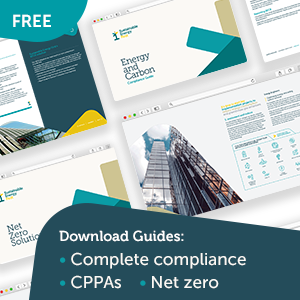The recent publication of the Sixth Carbon Budget from the Climate Change Committee (CCC) was a wake-up call: the UK is not on course to meet its legally binding target of net zero emissions by 2050, and the only hope of getting back on track is to accelerate the pace of transition.
The CCC believes that business is key to driving forward the kind of transformational change needed, and is calling on the government to put in place measures that will support businesses in their efforts to reduce emissions.
But most large and successful businesses aren’t waiting for the government to act. A recent survey of FTSE100 companies found that 45% of listed companies have already set net zero targets.
If your company is embarking on the process of transitioning to net zero, the CCC’s guidance for business sets out some key principles.
1. Full and accurate measurement of emissions
Setting an emissions target without accurately measuring your current emissions is like trying to map out a journey without knowing where you’re starting from. You need to calculate your company’s current emissions to give yourself a baseline, against which you can measure future progress.
Most big companies are already doing this; the FTSE100 survey we mentioned above found that 99% of listed companies are already measuring and reporting their carbon emissions. Unlisted businesses that are large enough to come under the scope of SECR will also be doing this as part of their reporting obligations.
2. Scope 3 inclusion
Scope 3 emissions (those emitted by a company’s value chain) are usually a substantial source of emissions, but many businesses haven’t fully addressed them because most of them are not compulsory to disclose under SECR. However, the CCC recommends that companies should “increase their focus” on Scope 3, even where this doesn’t result in a reduction to the company’s own reported emissions.
One example they give is in the area of energy supply. Many companies already have a renewable tariff with their supplier, which reduces Scope 2 emissions, but there is the opportunity to go further by entering into a Corporate Power Purchase Agreement (CPPA). This means engaging directly with an electricity generator, effectively becoming an investor for their renewables project. It might not alter your Scope 2 emissions on paper, but in reality you’re doing a lot more to support the transition to greener energy than if you just purchased existing renewables.
3. Ambition
If the UK is to meet our target of net zero by 2050, we will need to reduce emissions by 78% (against the 1990 baseline) by 2035. This means we effectively have to transform our society in less than a decade. Some sectors will be harder to address than others, which means that businesses in other sectors will have to reach net zero well ahead of 2050 if the UK is to meet its target.
The CCC says: “Companies across the UK should strive for the highest ambition – the earliest date – possible.” Investors and consumers are increasingly expecting to see this kind of approach, so a lack of climate ambition could see you lose out to competitors.
4. Ongoing monitoring
The CCC recommends measuring the company’s emissions regularly to track progress towards net zero. It is also important that these figures are made public, to show that the business is holding itself accountable. It may be too much paperwork to issue a formal public report more than once a year, but you could give internal updates more frequently than this.
Frequent monitoring and measuring your progress against interim targets is the best way to make sure you’re on track for net zero. If you find that the current plan isn’t working well enough, you can adjust it in good time.
5. Minimise the use of offsets
The CCC’s recommendation for the UK government is that it should aim to meet its net zero target without the use of international carbon credits. However, it accepts that some residual emissions are extremely difficult to get rid of and can only be balanced out by carbon offsetting. These include residual emissions from carbon capture and storage, wastewater treatment and the embodied carbon in buildings.
The advice for businesses is very similar: do what you can to reduce your own emissions before looking into offsets. At the beginning of a company’s net zero journey, there will be emissions that cannot be removed straight away. It is valid practice to consider offsetting to balance these and reduce the need for offsets over time as you implement your net zero strategy.
All offset projects must be “additional”; that is, they wouldn’t be happening unless your business paid for the offset, so you are truly helping to reduce or absorb the world’s overall carbon. And you should have a long-term plan for abandoning even these offsets in favour of new technologies for greenhouse gas removal, such as sustainable Bioenergy with Carbon Capture and Storage (BECCS).
Cutting the UK’s emissions in line with the Sixth Carbon Budget and our ultimate net zero target will involve big changes over the next decade. But many businesses are already on their own journey to net zero, and well prepared for transformative change.








